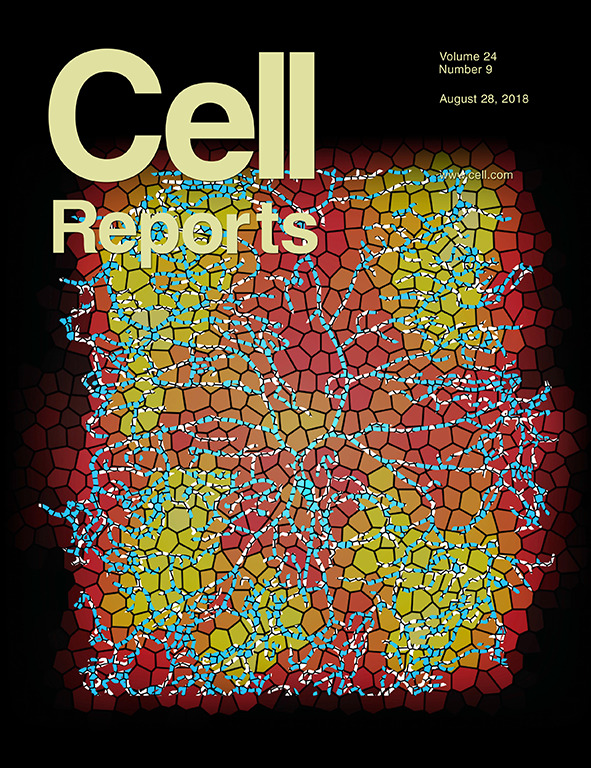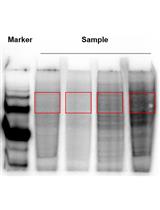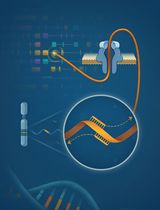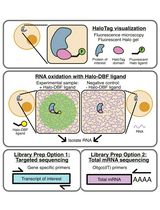- EN - English
- CN - 中文
Preparation of RNA 3’ End Sequencing Libraries of Total and 4-thiouracil Labeled RNA for Simultaneous Measurement of Transcription, RNA Synthesis and Decay in S. cerevisiae
制备酿酒酵母总RNA和4-硫尿RNA的RNA3'端测序文库用于转录,RNA合成和降解的同步测定
发布: 2019年03月20日第9卷第6期 DOI: 10.21769/BioProtoc.3189 浏览次数: 5389
评审: Gal HaimovichAnca SavulescuIndranil Malik
Abstract
Cellular RNA levels are determined by the rates of RNA transcription from the gene template and subsequent RNA stability. Knowledge about both transcription and RNA decay is, therefore, necessary to interpret RNA levels and gene expression, especially during cellular processes where these parameters change. Numerous experimental strategies have been developed to measure transcription and RNA decay rates. However, to our knowledge, none of those techniques can simultaneously interrogate transcription and RNA decay. The presented protocol allows this and provides a simple approach to simultaneously estimate total RNA levels, transcription and decay rates from the same RNA sample. It is based on brief metabolic labeling of RNA and subsequent concurrent sequencing of polyA+ and polyA- RNA 3’ ends. The protocol was developed in S. cerevisiae and should be broadly applicable.
Keywords: TranscriptionBackground
All cells express a multitude of RNA species and control of their RNA levels inside cells is a central function of life. Cells control levels of individual RNA species via regulation of their transcription and RNA decay rates. Hence, measuring those parameters has been a traditional focus area in molecular biology, and numerous techniques have been developed to interrogate them. Among the many methods to measure transcription, chromatin immunoprecipitation (ChIP) of RNA polymerase and its higher resolution variant ChIP-exo (Rhee and Pugh, 2011), global run-on sequencing (GRO-seq, Core et al., 2008) and its successor ‘Precision nuclear Run On sequencing (PRO-seq, Kwak et al., 2013), and nascent elongating transcript sequencing (NET-seq, Churchman and Weissman, 2011) are all readily applicable to genome-wide analysis and have, arguably, received most attention in recent years. RNA stability is usually measured by distinct methodology including pulse-chase type experiments or by following RNA decline after transcription shut-off. More recently, pulse-only application of metabolic labeling (i.e., with 4-thiouridine or 5-bromouridine) has been shown to allow for measurement of RNA stability without employing a chase (Miller et al., 2011; Sun et al., 2012, Neymotin et al., 2014; Rabani et al., 2014).
A major limitation of the above-mentioned approaches is that they rely on significantly different experimental approaches and measuring transcription and RNA decay, therefore, requires two different lines of experimentation. Hence, obtained measurements for transcription and decay rates are not directly comparable.
Recently, strategies based on brief metabolic labeling times combined with fragmentation of labeled RNA before purification (termed TT-seq or iTC-seq) were shown to provide a transcription-like measure from metabolic labeling experiments (Riising et al., 2014, Schwalb et al., 2016). However, even such an optimized procedure does not directly distinguish transcription from early post-transcriptional effects occurring during the labeling period.
To overcome these limitations, we developed a new approach, which is based on existing 4tU based protocols (Barrass et al., 2015), that allows to assay transcription together with total RNA levels and RNA decay rates (Schmid et al., 2018). Our method employs RNA 3’ end sequencing instead of conventional RNA-seq to measure RNA levels of both total and labeled RNA. Obtained data can be used to measure total RNA levels from the amount of pA+ RNA 3’ ends originating from gene 3’ ends, RNA production from the amount of pA+ RNA 3’ ends originating from gene 3’ ends in the labeled RNA fraction. Transcription can be directly estimated using the amount of pA- RNA 3’ ends within gene bodies. Finally, RNA decay rates can be derived from comparing RNA production to total RNA levels, or, alternatively, by comparing transcription and total RNA levels. The approach is simple, based on standard molecular biology techniques and does not require specialized equipment. Hence, it should be applicable to a wide range of experimental questions and model organisms. Here, we provide a detailed protocol for the RNA-seq library preparation part of the protocol.
Materials and Reagents
- 2 ml and 1.5 ml Eppendorf tubes (Hounisen, catalog numbers: 72.695.500 and 72.706)
- 15 ml Falcon tubes
- Zeba Spin Desalting Columns 7KMWCO (Thermo Scientific, catalog number: 89890)
- Oligonucleotides used
- S. pombe spike-in
ACT1_S. pombe_fwd CCATTCTTGCTTCTCTTTCTACTTTCC (Sigma-Aldrich, custom-made)
ACT1_S. pombe_rev CGCTCTCATCATACTCTTGCT (Sigma-Aldrich, custom-made) - S. cerevisiae pA+ RNAs
HHF1_fwd ACTGCCCGGTTTTTCTTCT (Sigma-Aldrich, custom-made)
HHF1_rev CCTAAACCCGCTATAATACACTCAT (Sigma-Aldrich, custom-made)
PMA1_fwd TACTGTCGTCCGTGTCTGGATCT (Sigma-Aldrich, custom-made)
PMA1_rev CCTTCATTGGCTTACCGTTCA (Sigma-Aldrich, custom-made)
TLC1_pA+_fwd TACTGTCGTCCGTGTCTGGATCT (Sigma-Aldrich, custom-made)
TLC1_pA+_rev CCTTCATTGGCTTACCGTTCA (Sigma-Aldrich, custom-made) - S. cerevisiae non-polyadenylated RNAs
SCR1_fwd CCCGGCTATAATAAATCGATCT (Sigma-Aldrich, custom-made)
SCR1_rev GCTGACGCTGGATAAAACT (Sigma-Aldrich, custom-made)
- S. pombe spike-in
- 4-thiouracil (Sigma-Aldrich, catalog number: 440736)
- Dry ice
- Phenol, pH 4.3 (Sigma-Aldrich, catalog number: P4682)
- Chloroform (Sigma-Aldrich, catalog number: 32211)
- Sodium acetate (Sigma-Aldrich, catalog number: S-8625)
- Sodium citrate (Merck, catalog number: 1.06448)
- Sodium chloride (Merck, catalog number: 1.06404)
- HEPES (Sigma-Aldrich, catalog number: H3375)
- Tris (VWR, catalog number: 103156X)
- EDTA (Merck, catalog number: 1.08418)
- Disodium hydrogen phosphate (Merck, catalog number: 1.06575)
- Sodium dihydrogen phosphate (Merck, catalog number: 1.06345)
- SDS (AppliChem, Panreac, catalog number: A1112)
- Magnesium chloride (Merck, catalog number: 1.05833)
- Glycogen (20 mg/ml) (Sigma-Aldrich, catalog number: G1508) (store at -20 °C)
- β-mercaptoethanol (Sigma-Aldrich, catalog number: M6250)
- MTSEA-biotin (Biotium, catalog number: 90064)
- Dimethylformamide (DMF) (Merck, catalog number: 1.03053)
- TURBO DNase free kit (Ambion, catalog number: AM1907M)
- SuperScript II (Invitrogen, catalog number: 18064-014)
- Platinum SYBR Green qPCR Super-Mix-UDG kit (Invitrogen, catalog number: 11733-046)
- Escherichia coli poly(A) polymerase kit (Thermo Fisher, catalog number: AM1350)
- PureLink micro RNA purification kit (Ambion, catalog number: 12183018A)
- Ribo-Zero Gold rRNA Removal kit for yeast (Illumina, catalog number: MRZY1306)
- RiboLock RNase Inhibitor (Thermo Scientific, catalog number: E00381)
- Lexogen QuantSeq 3’ mRNA-Seq Library Prep Kit REV (Lexogen, catalog number: 016.96)
- Dynabeads MyOne Streptavidin C1 (Invitrogen, catalog number: 65002)
- Ethanol 96% (VWR, catalog number: 83804)
- KOH (Merck, catalog number: P5958)
- SC amino acid mix (Merck, catalog number: Y1501; or home-made equivalent)
- Yeast nitrogen base (Merck, catalog number: Y0626)
- DMSO (Merck, catalog number: W387520)
- YPAD growth medium (Merck, catalog number: Y1375; or home-made equivalent)
- Acetic acid (Merck, catalog number: 1005706)
- NaOH (Merck, catalog number: S8045)
- HCl (Merck, catalog number: H1758)
- URA- medium (synthetic growth medium without uracil) (see Recipes)
- 4tU stock (see Recipes)
- TES (see Recipes)
- S. pombe spike-in RNA (see Recipes)
- RNA storage solution (see Recipes)
- 3 M NaOAc (see Recipes)
- MTSEA-biotin stock (see Recipes)
- 1 M HEPES-KOH, pH 7.5 (see Recipes)
- 0.5 M EDTA-NaOH, pH 8 (see Recipes)
- 1 M NaPi buffer, pH 6.8 (see Recipes)
- 10x NaMg (see Recipes)
- 1x NaMgPS (see Recipes)
- TEN1000 (see Recipes)
- 0.7 M β-mercaptoethanol (see Recipes)
- 20 mg/ml Glycogen (see Recipes)
Equipment
- DynaMag-2 magnet (Thermo Fisher Scientific, catalog number: 12321D)
- Incubator (30 °C, with agitation for 500 ml flasks)
- Centrifuge (for 50 ml tubes)
- Microcentrifuge (cooled, for Eppendorf tubes)
- Thermomixer (for Eppendorf tubes, heating up to 65 °C)
- Rotating wheel
- Real-time PCR system (Agilent, model: AriaMX, catalog number: G8830A)
- Bioanalyzer (Agilent, model: Bioanalyzer 2100)
- Qubit 2.0 Fluorometer (Life Technologies)
- NanoDrop UV spectrophotometer
- Centrifuge bucket (or flask)
- Autoclave
- Vortexer
- 4 °C refrigerator
- -20 °C freezer
- -70 °C freezer
Procedure
文章信息
版权信息
© 2019 The Authors; exclusive licensee Bio-protocol LLC.
如何引用
Schmid, M., Tudek, A. and Jensen, T. H. (2019). Preparation of RNA 3’ End Sequencing Libraries of Total and 4-thiouracil Labeled RNA for Simultaneous Measurement of Transcription, RNA Synthesis and Decay in S. cerevisiae. Bio-protocol 9(6): e3189. DOI: 10.21769/BioProtoc.3189.
分类
分子生物学 > RNA > RNA 测序
您对这篇实验方法有问题吗?
在此处发布您的问题,我们将邀请本文作者来回答。同时,我们会将您的问题发布到Bio-protocol Exchange,以便寻求社区成员的帮助。
Share
Bluesky
X
Copy link














